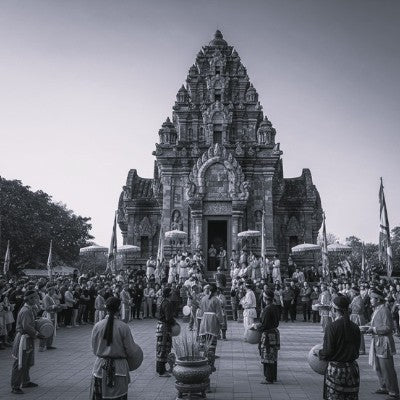Menu
-
-
F.A.Q
- How to identify genuine agarwood chip, natural or cultivated
- How to identify oil injection / absorption fake agarwood beads
- How to know if there are more than one oil in your oil
- How to make your wood bracelet or mala darker
- How to tell if an Agarwood bead sinks WITHOUT sinking it under water?
- How does back flow incense work and how do you burn it?
- Where to start if you don't know what agarwood is ?
- Why are you losing money if you buy seeds and plants?
- Which agarwood incense should I choose?
- Frequently Asked Questions
- Agarwood Related Articles
- Shipping
-
SHOP - Agarwood
-
SHOP - Other Fragrant Wood
-
SHOP - Incense Holder and Burner
-
- FREE Oud Oil guide
- Testimonials
- "Why did you buy this?"
- Contact us
- About Us
- +61430284329
- Login
-
English


Agarwood and the Cham People in Vietnam
July 07, 2025 5 min read
Bao, my trade associate, who lives in Central Vietnam (mien Trung), shares some Agarwood stories with me.
A Journey Through Agarwood, the Cham People, and Their Sacred Lands
Bao was born in 1975 in Da Nang, and he never truly understood the soul of this land until he began to follow the smoke—the scent of agarwood—into the temples, forests, and stories whispered by its oldest people.
Growing up and moving around Khánh Hòa, Ninh Thuận, and Bình Thuận, he learnt from the Cham people, the sacred forests, and a resinous heartwood known as Trầm Hương. What began as a search for cultural insight became a spiritual initiation into something much older than himself.
One of his earliest introductions came from the writings of Cristoforo Borri, a Jesuit missionary who lived in Đàng Trong in the year 1621. In his observations, he described a forest product so powerful that even buried deep beneath the soil, its scent would rise to the surface. This, Borri wrote, was Kỳ Nam—a rare and more potent form of agarwood (you can learn more here)

During the Nguyễn dynasty, trầm hương was state-controlled:
-
Only licensed gatherers could harvest it
-
It was collected from February to June each year
- Those who withheld trầm from officials faced imprisonment
Under French colonial rule, agarwood control was shifted to forestry departments. Even then, harvesting required permits. Smuggling and secret trade were common, especially with Chinese merchants.
Borri also wrote of how ships from the West sailed home full of agarwood, making their owners rich. But he also noted that the finest specimens were tightly guarded by the local kings, who treated this wood not as mere merchandise, but as treasure from the divine.
Still, Borri's writings only scratched the surface. The forest held deeper secrets—ones only locals dared to speak of.
The People Who Walked with the Forest

The Cham people are famous for their tower architecture, particularly the Po Nagar Tower in Nha Trang, which is dedicated to Thiên Y Thánh Mẫu, the Mother Goddess. In Tháp Bà Thiên Y A Na, scholar Ngô Văn Doanh quoted an ancient Cham inscription that said:
“The Goddess Po Inu Nagar created the land, people, agarwood, rice… all things on Earth.”
This sacred link between agarwood and the divine has deep roots in Khánh Hòa’s history. But nature also plays a vital role. Geologically, Khánh Hòa lies at the heart of Vietnam’s coastal arc, formed by ancient volcanic activity. The region’s soil is rich and diverse—made from granite and basalt—and perfect for nurturing the cây dó bầu.
The sea here is a meeting point of warm and cold currents, creating a mild climate with plentiful sun and rain. These ideal conditions make Khánh Hòa the perfect natural sanctuary for agarwood trees, and the cultural heart of Vietnam’s agarwood heritage.
In Ninh Phước, during the days leading up to the Kate Festival, he met an old Cham elder. She told him that agarwood was not found—it revealed itself to the right person.
Strange indeed!
She explained the ritual of "ngậm ngải" ( hold Magic Herb in your mouth) —an ancient practice where a chosen person would chew a sacred root before entering the forest in search of trầm. These were not casual foragers. They were initiates, often risking their lives for a scent formed only by time, injury, and spirit.
“Some do not come back,” she said.
“Some go too far. Some become part of the forest. There are tigers that used to be men.”
It echoed what Quách Tấn recorded in Xứ Trầm Hương:
“Trầm không bán bằng bạc vàng, mà bằng tuổi thọ.”
“Agarwood is not sold for silver or gold, but in exchange for years of one's life.”
In the highlands, Bao was shown shrines in the jungle—simple stones or burned stumps—dedicated to Thiên Y A Na, the Mother Goddess of the land. Offerings were left not just for luck, but for permission. One could not simply take trầm -Agarwood. The forest had to agree.

Kate Festival – Where Smoke Meets Spirit


Bao returned to Ninh Thuận during Kate, the most sacred celebration of the Cham calendar. The towers of Po Klong Garai blazed in the sun, their ancient bricks glowing as if lit from within. The Cham gathered in colourful garments. Drums echoed across the hillside. And then came the silence.
A woman named Bajau stepped forward. She placed a piece of trầm hương (Agarwood) on the coals. The smoke curled upward, slow and deliberate, as if it knew where it was going. The crowd watched in reverence—not worshipping the smoke, but what it represented: the invisible bridge between this world and the divine.
No words were needed. Agarwood was the voice of memory, of offerings, of continuity.
The Last Story I Was Told
Before Bao left, a Raglai man from the western hills told me his family once kept the sacred garments of the gods. During Kate, they would descend from the mountains to bring the ceremonial robes of Po Rome and Po Ina Nagar to the Cham towers.
He carried a piece of agarwood tied with a string and tucked in a pouch.
“This,” he said, “is for the spirit’s road. In case I forget my way.”
He meant the road between life and death.
The Scent That Remains
Today, when I light a piece of trầm hương (Agarwood) at home, I no longer see it as just incense. I see the forest. I see the red towers. I hear the drums and remember the stories of men who became tigers, of kings who burned agarwood to speak with the gods, of Cham women who whisper prayers through the smoke.
Agarwood is not a product. It is a wound that became a blessing.
It is a breath from the forest, waiting to be heard.
And if you ever come to the land of Central Vietnam, step lightly.
Breathe deeply.
And listen. The forest still remembers.
Sustainably grown Agarwood
With great respect to nature, we now grow our Agarwood. There is no need to risk human lives and upset the Mother of Nature. This way, we can keep our culture as well as our environment
Leave a comment
Comments will be approved before showing up.
Also in News

What is Tasbih? The Deep Meaning of Subhan Allah and the Role of Prayer Beads
November 09, 2025 4 min read

